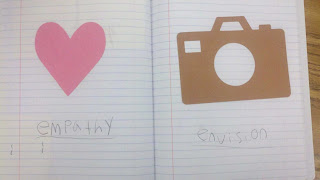This summer I received training in the Balanced Literacy framework from Teachers College Reading and Writing Project. I spent time on Pinterest and reading other teaching blogs. I compiled my ideas and combined them all together into a template that meets my teaching needs. This is the Reading Notebook I have designed for my students to use. They actively use it and so far so good!
I organized it into 3 sections: Independent, Read Aloud, Minilesson. Students put their jottings on sticky notes in the Independent section after they finish a book. They put the book title at the top of the page and then the jottings underneath. During Read Alouds students can stop and jot, stop and sketch, make predictions, and record other responses. In the minilesson section I can have students draw Thinking Maps to display information about the book, they can glue templates for activities, or they can write responses or questions.
This library pocket is on the inside back over. Partners can write notes to each other about their books. They can also put questions in there. I also use this pocket as a way to differentiate between the two literacy blocks that I teach. My inclusion block does not have this pocket in their Reading Notebooks.
This pocket is on the inside front cover. If students see a book they want to read but someone else has it they can write it down and put it in the pocket. The student's reading level is also written on the pocket.
As the culminating lesson of Unit 1 "Building a Reading Life" in Lucy Calkins' Reading Workshop, students decorated their Reading Notebooks to reflect their new reading lives. They used clip art, photos from home, and old Scholastic book order forms!
They listed their favorite book topics.
fluency tips
student self-assessment and goals foldable in the independent section of the notebook
empathy and envision reminders in the minilesson section
high five retelling in the minilesson section
envisioning jotting in the read aloud section
well, the spelling needs work, but these are jottings in the minilesson section after learning how to revise a mental movie after reflecting on characters' actions
I used a story wheel during one of my read aloud lessons and afterwards these students sat in front of the anchor chart and recorded one of their own in the Reading Notebooks in the read aloud section. I got the story wheel lesson from the Better Lesson website (click here to visit this extremely resourceful site).
During our character study students added a list of character traits to the minilesson section. They also added the template for a biopoem--a more rigorous way of describing a character.
I will add more details and photos from our Reading Notebooks as the year progresses.


















No comments:
Post a Comment